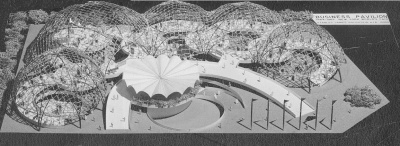|
Everyone wanted to "Come to the Fair!"
After all, it was going to be the New York World's Fair.
New York was the center of the universe in the mid-twentieth
century. Headquarters to the United Nations, it was the world's
capitol. Headquarters to the largest financial institutions and
corporations, it was the economic center of the universe. A twelve-story
globe in the middle of the Fairgrounds was no small boast. To
be a part of New York's World's Fair was an expression
of power and prestige. And the opportunity to sell a message,
a product or a nation to 70 million projected visitors was a
tantalizing prospect indeed.
The press reported with great fanfare the
announcements of the Fair Corporation. Week after week new countries,
states, companies and organizations were signing on with the
Fair. Steadily, the huge site map at the Administration Building
began to fill with the names of exhibitors who had agreed to
lease space. By the autumn of 1962, the map boasted such names
as General Motors, the Soviet Union, Puerto Rico and the Virgin
Islands, Argentina, Mexico, Kodak, The World of Food, The World
of Toys, the Heartland States, Japan, Ecuador and the State of
Georgia, to name just a few.
Exhibiting at the Fair would be an expensive
proposition. Site rental and import duties on construction materials
and exhibits had to be considered. Architectural and engineering
fees, landscaping costs, and union labor to construct pavilions
were another consideration. Then there were the costs of operation
once the Fair opened: staffing and grounds upkeep and refuse
removal. These weren't Topeka costs. These were New
York costs.
The Bureau of International Exhibitions
(BIE) had denied official approval of the Fair and the thirty
(mostly western European nation) members of the organization
were banned from officially participating. The Fair Corporation
was forced to solicit trade and commerce organizations within
these countries to host exhibits in lieu of official government
participation. If Switzerland was barred from displaying her
national culture because of membership in the BIE, perhaps the
Swiss watch industry could be persuaded to exhibit their goods
to represent Switzerland in her place. Or perhaps not. The stronger
the trade or commercial industry, the more likely the participation
of the international state. Nations who were not a party to the
BIE were often poor or just emerging from years of colonial rule
and found it difficult to secure funding for representation at
the Fair despite eagerness to show their pride in new-found nationhood.
And while New York's unofficial World's Fair was trawling
the world for participation, official BIE sanctioned World's
Fairs in Seattle (1962) and Montreal (1967) were vying for a
piece of international budgets as well.
In the case of the American states, legislative
approval had to be gained and appropriations made from tax revenue
to host a pavilion. Some legislatures met for only a few months
out of the year and lacked time to enact legislation. Many had
to budget for participation and sell the idea of being a part
of the Fair to constituents. If official state government sponsorship
couldn't be gained, perhaps a trade or commerce organization
within the state would sponsor a state's pavilion. Or perhaps
not.
The 1939 World's Fair had constructed "halls"
where multiple industrial firms could rent exhibit space at a
nominal fee from the Fair. Many of these Fair-sponsored pavilions
had gone half-empty and were money losers for the first New York
World's Fair. This World's Fair vowed not to make the same mistake.
Smaller companies who wished to participate would have to sign
on with private organizations looking to put up such structures
as "The Transportation & Travel" pavilion and the
"Marine Center." However, these structures could only
be constructed if enough clients could be found to make the enterprise
profitable for the sponsor.
Small
Business Pavilion
|

|
| A proposed multi-exhibitor, the
Small Business Pavilion would have consisted of five connected
geodesic domes housing exhibits of smaller American businesses
in a mall-like atmosphere. The pavilion was never constructed. |
In the final analysis, the high costs,
the BIE fiasco and the aversion of the Fair to provide little
if any financial support to any exhibitor made it virtually impossible
for many eager participants to come to the Fair. Exhibiting at
the New York World's Fair was the dream of many. In reality,
it was simply too expensive for all but a few. It is no wonder
then that the map of the Fair began to fill with "phantom"
pavilions as this reality sunk in. Major exhibits, announced
with great flourish, would quietly disappear from the site map
with little or no comment. The Fair was not as anxious to share
their disappointments with the public as they were their successes.
Thus, the pavilions of Russia, France, Israel, the Netherlands
and Italy; the Graphic Arts pavilion and The World of Toys; the
Michigan, Georgia and Alabama pavilions; the Grayson-Robinson
Stores and Aero Space pavilions, along with many others, simply
disappeared leaving behind only a press clipping, a name on a
map or a few architectural renderings.
|